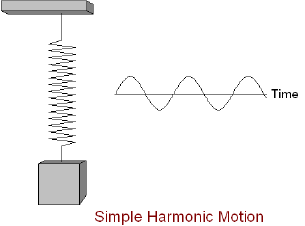Simple Harmonic Motion
Claimed by Mary Francis McDaniel
Simple harmonic motion is an approximation that ignores friction and air resistance. Although this assumption can often not be made in everyday calculations, simple harmonic motion can approximate these otherwise complicated situations, fairly well. Simple harmonic motion can be used to estimate many systems including spring-mass systems and the swinging of a pendulum in certain instances which will be explained in further detail below. This Wiki Page will discuss simple harmonic motion which is discussed in detail in Chapter Four: Contact Interaction.
The Main Idea
Simple harmonic motion is a periodic motion, a motion that is repeated over some time interval. This periodic motion has a restoring force, a force that is always working to return the system to equilibrium position, that is proportional and opposite to displacement. Due to this as the system gets farther from equilibrium position the larger the force is to return it to equilibrium position. When no friction or air resistance is present the system will continue to oscillate as the restoring force decreases as the object gets closer to equilibrium position until the force reaches zero, but at which point the particle continues due to its initial momentum until passes equilibrium position. Then the restoring forces increases in the opposite direction until the momentum is changed enough to change the direction of the particle and the process repeats. A common example of simple harmonic motion is an undamped spring-mass system, or one that does not proceed to rest due to friction or another dissipative force. 
A Mathematical Model
The force of this system can be found using [math]\displaystyle{ \vec{F}={-K_{s}}*s*\vec{Lhat} }[/math] where [math]\displaystyle{ s=L-{L_{o}} }[/math]. This equations stems from Newton's Second Law and Hooke's Law which is a first order linear approximation for forces acting on an elastic system, such as a spring. The solution to this differential equation is [math]\displaystyle{ x=cos(ωt) }[/math] where [math]\displaystyle{ ω=√({K_{s}}/m) }[/math]. From this equation we can determine that the period for this function, or the time it takes an object to make one complete cycle of motion, to be [math]\displaystyle{ T=2πω }[/math].
A Computational Model
Click here to see a spring-mass system displaying simple harmonic motion in vPthyon
Examples
Be sure to show all steps in your solution and include diagrams whenever possible
Simple
Middling
Difficult
Connectedness
One interesting application of simple harmonic motion is its ability to approximate the interatomic vibration of molecules which I find very interesting as an Earth and Atmospheric Science major, trying to better understand our environment and how the molecules it is made up of interact. I have always been very intrigued by the composition and interactions of molecules and this approximations brings me another step closer to understanding how our world works. An interesting industrial application of simple harmonic motion is its approximation of a car running on worn down shock absorbers.
History
Put this idea in historical context. Give the reader the Who, What, When, Where, and Why.